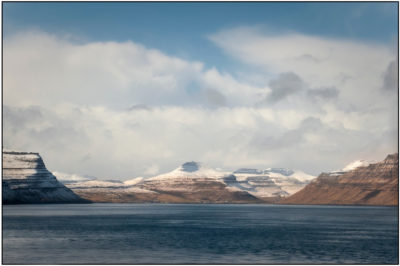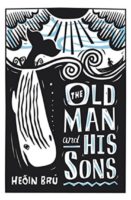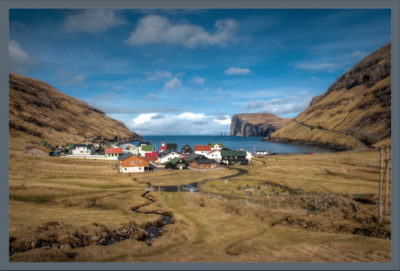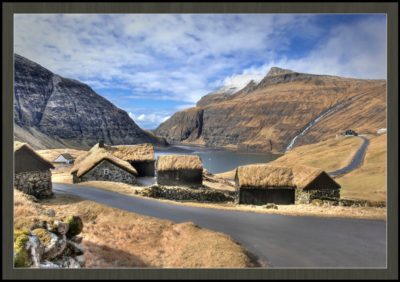by Bill Murray

Last month, local people drove fourteen hundred dolphins to the end of Skálafjordur Bay near the capital of the Faroe Islands and killed them. It is a tradition called the grindadráp. In Icelandic, one of the neighboring languages, “Good luck” is hvelreki, with an idea something like “may a whole whale wash up on your beach.” The Faroese don’t wait for luck to produce whales. They sail out and find them.
When a fishing boat or a ferry spies a pod of whales (dolphins in this case but usually whales), a call goes out and word races through the village. Even in the middle of a work day people drop what they are doing and muster. Fishing boats form up in a half circle behind the whales and, banging on the sides of the boats and trailing lines weighted with stones, press the whales into a shallow bay.
Townspeople wait on the beach with hooks and knives. Mandated under new regulations, two devices, a round-ended hook and a device called a spinal lance are designed to kill the whales more quickly and thus, grindadráp proponents say, more humanely.
The hunter plunges the hook attached to a rope into the whale’s blowhole. Men line up tug of war style to pull the whale onto the beach. It takes a line of men to haul them out, for pilot whales may weigh 2500 pounds. The grizzled fisherman, the mayor, the hardware clerk with a bad back, all the townspeople fuse in common cause, shoulder to shoulder on the shore, harvesting the meat, dividing the spoils.
The harvest is distributed evenly, for communal benefit. This is real, retail, hands-on constituent services for the mayor, who works out what size the shares should be and hands out tickets. People go to stand beside the whale indicated on their ticket. Those sharing each whale butcher it together, right there, right then. The municipality is mandated to clear the remains within 24 hours.
The animals are cut and pieces laid on the ground skin down, blubber up. Then the meat is cut from the whale and laid atop the blubber, the whole take is divided, and the shareholders gather up their haul and carry it home. There is no industrial processing.
Even today whale accounts for a quarter of all the Faroes’ meat consumption. Custom and tradition tip the scales against the advice of the then-Faroes’ Chief Medical Officer Dr. Høgni Debes Joensen, who declared in 2008 that no one ought to eat whale meat anymore because of the presence of DDT derivatives, PCBs and mercury in the meat.
 Heðin Brú (1901-1987), perhaps the Faroes’ most important novelist, describes life in the village of Sørvágur, now adjacent to the airport on the island of Vagar, in his The Old Man and His Sons. Set in subsistence era early twentieth century Faroes, it describes the generational strains on a rural society being dragged into modernity.
Heðin Brú (1901-1987), perhaps the Faroes’ most important novelist, describes life in the village of Sørvágur, now adjacent to the airport on the island of Vagar, in his The Old Man and His Sons. Set in subsistence era early twentieth century Faroes, it describes the generational strains on a rural society being dragged into modernity.
Brú works to show the grindadráp (‘the grind’ for short), as vital in feeding the islanders. In 1928 a Faroese medical officer wrote, “…it cannot be emphasised enough how important this [pilot whale meat] is for the population, for whom the meat, be it fresh, dried or salted, is virtually their only source of meat.”
•••••
Once the grindadráp was a quirky cultural asset, but not anymore. In a time when people are quick to pass judgement, the grind pits the world against the Faroes. A tinge of the exotic attaches to today’s grindadráp, a summoning of vestigial heritage and pride, a suggestion that these quiet, unassuming subjects of the Danish crown fall into some bloodlust frenzy wild and savage, like Viking wildmen in helmets with horns only more authentic than horned Trump Sturmtruppen.
Now the Faroese live in a society modern in every way, right down to their efforts to find more humane ways to kill the whales, and whale meat is no longer required for the diet as it was in the days of Heðin Brú. The subsistence era was a different time. So the question arises, must the tradition continue?
Last month’s photos of the crimson harvest are revolting, and the idea of slaughtering some of the world’s most intelligent creatures is unsettling no matter who you are. But it must also be said that the Faroes’ intent is to be sustainable. The North Atlantic Marine Mammal Conservation Organization (apparently yes, that is a thing) reckons the annual Faroese slaughter takes less than 0.1 percent of the pilot whale population, the grind’s usual target.
Proponents call the grind socially adhesive, a big bundle of sport, tradition and a way of obtaining cheap food. It is also a direct link to the islanders’ past. Opponents assert that none of these justifications hold up in the 21st century. Yet in a place not very accommodating to agriculture, fishing – and pilot whales – have always been central to the Faroese diet.
You can be sure that isolated people will always mix resourcefulness with resistance to change. Pride, too. Pride in the ability to live and flourish in an outpost. Pride in the traditions that make the place unique.

Traditions like the Stakksdagur festival. Every year in spring outside the postcard-perfect village of Tjørnuvik at the far end of Streymoy, strong men drive a few rams up into the hills to roam wild. On a Saturday as autumn approaches, islanders converge, out for a bit of tradition and a day of drinking and playing Viking, carry spiked wooden poles into the mountains, find the rams and use the poles to make a pen to confine them. To fanfare, commotion, camaraderie and traditional song, they herd the rams back into Tjørnuvik for slaughter and auction.
Call it the Faroese equivalent of tailgating on a college football Saturday. It’s as vaguely exotic as Scottish pole tossing, Swedes around the Midsummer pole or the Shetland’s Up Helly Aa.
When you’ve repeatedly been to the brink of starvation, when you live on a spot of land as precarious as the obstinate Faroes cliffs of slippery basalt, when your heritage reaches to Odin and Thor, when you have come through all this and more and today you thrive, perhaps there’s room for the stout view that your culture is worth preservation.
Elin Brimheim Heinesen, a Faroese musician, sharpens the point: “What is completely natural for people in the Faroes, seems so alien to other people, who have never lived here – or in similar places – so they can’t possibly understand the Faroese way of life. And thus many of the aspects of this life provokes them. People are often provoked or disgusted by what they don’t understand.”
She wants the casual visitor to understand that life still is really different on this small archipelago in a vast ocean, “that it is necessary to interrupt your daily work when the time is ripe to bring the sheep home and slaughter them, or go bird-catching, or go hare-hunting – or participate in pilot whaling – and, additionally, to prepare and store the food you have provided for yourself and your family. This food constitutes a large part of the total food consumption and is completely indispensable for most families – especially for the 12% in the Faroe Islands who live at or below the poverty line.”
Activists battle the grind and the Faroes’ legislature battles back. The parliament, called the Løgting, briefly voted in 2014 to ban members of the marine wildlife conservation organization Sea Shepherd from sending protesters. That legislation was dropped when Denmark determined it would likely be illegal.
But try, try again; a 2016 proposal to keep anti-whaling activists out equates actively protesting for an organization with work, for which foreigners require a work permit.
Hapag-Lloyd and AIDA, two big German cruise lines, have suspended or lessened arrivals in the Faroes to protest the grind. (This may be devastating to waterfront vendors but it has its appeal for those of us who believe there is a special place in hell for the inventor of the mega-cruise ship.)
The Faroese point out that the grind is an opportunistic hunt, not commercial, the meat is not exported and is shared across the entire community. The distribution of the spoils generally happens without money, and on the spot.
In the conservative British magazine The Spectator, Heri Joensen, the lead singer of the Faroese band Tyr writes, “In the Faroes, it is not uncommon to kill your own dinner — be it sheep, fish, bird or hare. I have slaughtered many more sheep than I have cut up whales and no one seems to care. I find that strange. Why the double standards? Because whales are endangered? The ones we eat aren’t. There are an estimated 780,000 long-finned pilot whales in the Atlantic. In the Faroe Islands, we kill about 800 a year on average — or 0.1 per cent of the population. An annual harvest of 2 per cent is considered sustainable: compare that with the billions of animals bred for slaughter.” Joensen says that buying the same amount of cow meat he got in a grindadráp would have cost more than £800.

So much discourse these days is about listing things one person or another ought not do. But I think most people don’t mean it, or at least don’t mean it deeply. Passing judgement on social media is a cheap way to signal group identity.
It’s fair to say that one look at the business end of Skálafjordur Bay last month, crimson and slick with dolphin blood, turned legions of foreigners judgmental against the Faroese. The islanders counter that most of their critics, who live entirely apart from the source of their food, eat animals who suffer every bit as much as a grindadráp whale. Factory farming, they say, is an industrial scale horror for profit, while the grind has no financial motive. Who are you, they ask, to pass judgement on the people of a small group of islands far away?
